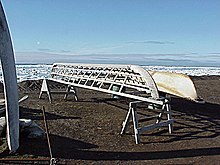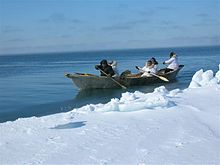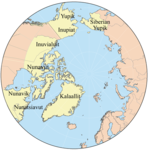Eskimo is an exonym that refers to two closely related Indigenous peoples: Inuit and the Yupik of eastern Siberia and Alaska. A related third group, the Aleut, who inhabit the Aleutian Islands, are generally excluded from the definition of Eskimo. The three groups share a relatively recent common ancestor, and speak related languages belonging to the family of Eskaleut languages.
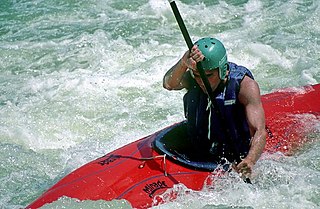
A kayak is a small, narrow human-powered watercraft typically propelled by means of a long, double-bladed paddle. The word kayak originates from the Inuktitut word qajaq. In British English, the kayak is also considered to be a kind of canoe.

Whaling is the hunting of whales for their usable products such as meat and blubber, which can be turned into a type of oil that was important in the Industrial Revolution. Whaling was practiced as an organized industry as early as 875 AD. By the 16th century, it had become the principal industry in the Basque coastal regions of Spain and France. The whaling industry spread throughout the world and became very profitable in terms of trade and resources. Some regions of the world's oceans, along the animals' migration routes, had a particularly dense whale population and became targets for large concentrations of whaling ships, and the industry continued to grow well into the 20th century. The depletion of some whale species to near extinction led to the banning of whaling in many countries by 1969 and to an international cessation of whaling as an industry in the late 1980s.
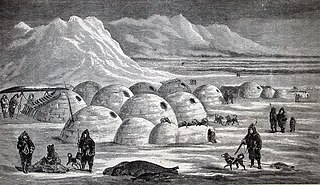
An igloo, also known as a snow house or snow hut, is a type of shelter built of suitable snow.

The Inupiat are a group of Alaska Natives whose traditional territory roughly spans northeast from Norton Sound on the Bering Sea to the northernmost part of the Canada–United States border. Their current communities include 34 villages across Iñupiat Nunaat, including seven Alaskan villages in the North Slope Borough, affiliated with the Arctic Slope Regional Corporation; eleven villages in Northwest Arctic Borough; and sixteen villages affiliated with the Bering Straits Regional Corporation. They often claim to be the first people of the Kauwerak.
The Thule or proto-Inuit were the ancestors of all modern Inuit. They developed in coastal Alaska by 1000 AD and expanded eastward across northern Canada, reaching Greenland by the 13th century. In the process, they replaced people of the earlier Dorset culture who had previously inhabited the region. The appellation "Thule" originates from the location of Thule in northwest Greenland, facing Canada, where the archaeological remains of the people were first found at Comer's Midden.

Point Barrow or Nuvuk is a headland on the Arctic coast in the U.S. state of Alaska, 9 miles (14 km) northeast of Utqiagvik. It is the northernmost point of all the territory of the United States, at 71°23′20″N156°28′45″W, 1,122 nautical miles south of the North Pole.
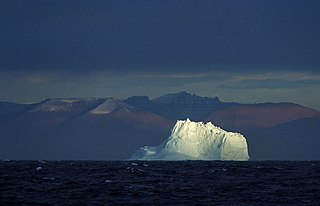
The Greenland Sea is a body of water that borders Greenland to the west, the Svalbard archipelago to the east, Fram Strait and the Arctic Ocean to the north, and the Norwegian Sea and Iceland to the south. The Greenland Sea is often defined as part of the Arctic Ocean, sometimes as part of the Atlantic Ocean. However, definitions of the Arctic Ocean and its seas tend to be imprecise or arbitrary. In general usage the term "Arctic Ocean" would exclude the Greenland Sea. In oceanographic studies the Greenland Sea is considered part of the Nordic Seas, along with the Norwegian Sea. The Nordic Seas are the main connection between the Arctic and Atlantic oceans and, as such, could be of great significance in a possible shutdown of thermohaline circulation. In oceanography the Arctic Ocean and Nordic Seas are often referred to collectively as the "Arctic Mediterranean Sea", a marginal sea of the Atlantic.

Muktuk is a traditional food of Inuit and other circumpolar peoples, consisting of whale skin and blubber. A part of Inuit cuisine, it is most often made from the bowhead whale, although the beluga and the narwhal are also used. It is usually consumed raw, but can also be eaten frozen, cooked, or pickled.

Qeqertarsuatsiaat, formerly Fiskenæsset or Fiskernæs, is a settlement in the Sermersooq municipality in southwestern Greenland, located on an island off the shores of Labrador Sea. Its population was 169 in 2020.

The baidarka or Aleutian kayak is a watercraft consisting of soft skin over a flexible space frame. Without primarily vertical flex, it is not an iqyax. Its initial design was created by the Aleut people (Unangan/Unangas), the Indigenous people of the Aleutian Islands.

Inuit are a group of culturally and historically similar Indigenous peoples traditionally inhabiting the Arctic and subarctic regions of North America, including Greenland, Labrador, Quebec, Nunavut, the Northwest Territories, Yukon (traditionally), Alaska, and Chukotsky District of Chukotka Autonomous Okrug, Russia. Inuit languages are part of the Eskimo–Aleut languages, also known as Inuit-Yupik-Unangan, and also as Eskaleut. Inuit Sign Language is a critically endangered language isolate used in Nunavut.

The bowhead whale, sometimes called the Greenland right whale, Arctic whale, and polar whale, is a species of baleen whale belonging to the family Balaenidae and is the only living representative of the genus Balaena. It is the only baleen whale endemic to the Arctic and subarctic waters, and is named after its characteristic massive triangular skull, which it uses to break through Arctic ice.

Arctic Umiaq Line A/S (AUL) or Arctic Umiaq is a passenger and freight shipping line in Greenland. Its name derives from the Kalaallisut word for the traditional Inuit passenger boat, the umiak, distinguished from the kayak, used for hunting. The sea connection provided by Arctic Umiaq provides supplies and communication to the entirety of western and southwestern Greenland. It is a wholly owned subsidiary of the Royal Arctic Line.

The tupiq is a traditional Inuit tent made from seal or caribou skin. An Inuk was required to kill five to ten ugjuk to make a sealskin tent. When a man went hunting he would bring a small tent made out of five ugjuit. A family tent would be made of ten or more ugjuit.

Subsistence hunting of the bowhead whale is permitted by the International Whaling Commission, under limited conditions. While whaling is banned in most parts of the world, some of the Native peoples of North America, including the Inuit and Iñupiat peoples in Alaska, continue to hunt the Bowhead whale. Aboriginal whaling is valued for its contribution to food stocks and to cultural survival, although the days of commercial whaling in the United States and in Canada are over.
Whaling in Canada encompasses both aboriginal and commercial whaling, and has existed on all three Canadian oceans, Atlantic, Pacific, and Arctic. The indigenous peoples of the Pacific Northwest Coast have whaling traditions dating back millennia, and the hunting of cetaceans continues by Inuit. By the late 20th century, watching whales was a more profitable enterprise than hunting them.
Tom Akeya is an Inuit ivory carver. His work has been sold in multiple places.
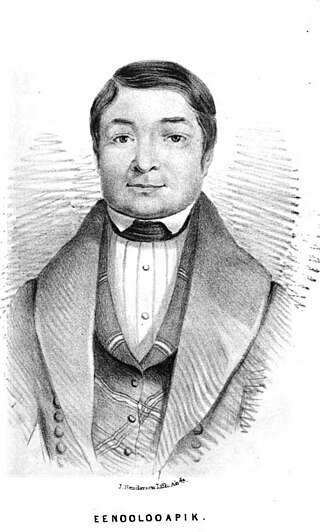
Eenoolooapik, also spelled Inuluapik, was an Inuit hunter and guide who served with British whaler William Penny and visited Scotland. Born on Blacklead Island in Cumberland Sound, Eenoolooapik moved with his family to the island of Aggijjat on the eastern coast of Baffin Island. Acquainted as a youth with Scottish whalers operating in the area, he accompanied Penny to Aberdeen, Scotland in 1839, as part of Penny's attempt to lobby for greater funding for Arctic exploration. Eenoolooapik returned to Baffin in 1840 after visiting Greenland. Alexander McDonald published a biography of Eenoolooapik in 1841, likely the only contemporary full-length biography of any Inuit published during the 19th century. In 1847, he died of tuberculosis developed during his time overseas.

Inuit navigation techniques are those navigation skills used for thousands of years by the Inuit, a group of culturally similar indigenous peoples who inhabit the Arctic and subarctic regions of Greenland, Canada, and Alaska. On the tundra, Inuit hunters would travel for long distances when hunting for game, and on the coastal waters, hunters would travel out of the sight of land, and they would need to orientate themselves to the location of favoured fishing or hunting places, or on the return journey to their dwelling place.

